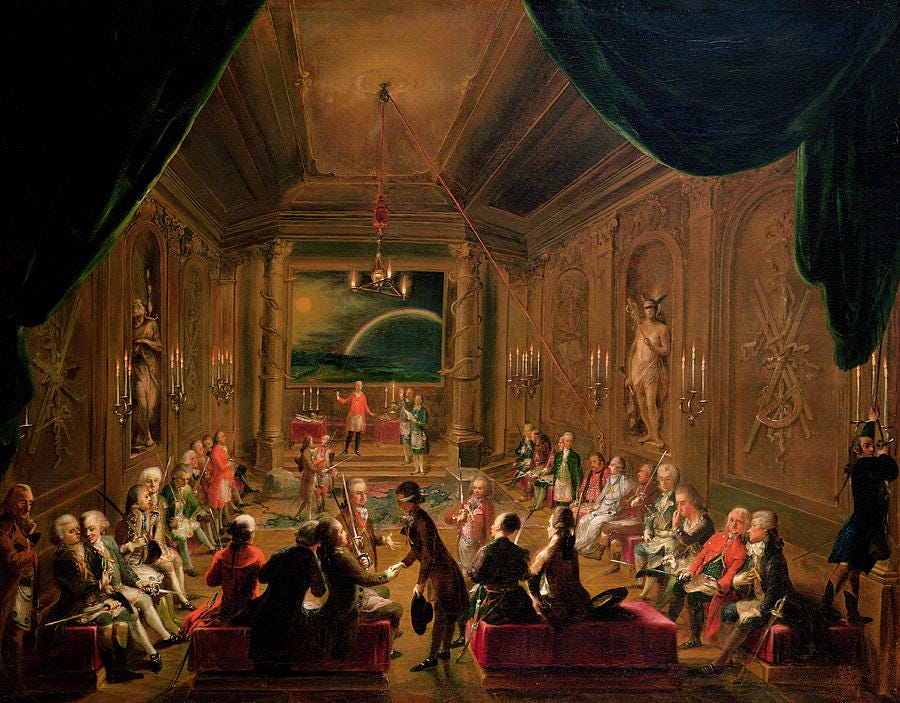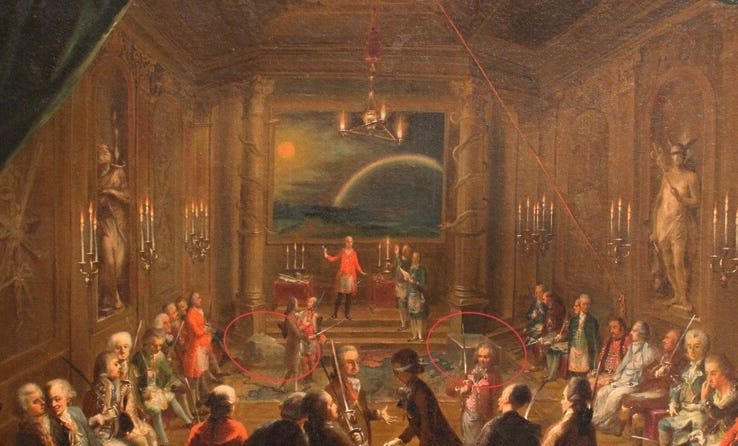'Interior view of a Viennese lodge'
The Lodge painting by Italian artist Ignaz Unterberger that includes Bro. Mozart
An oil painting of circa. 1789 believed to have been painted by Italian artist and Freemason Bro. Ignaz Unterberger (1748-1779) and can be seen on display in the Historical Museum of the City of Vienna purchased by them in 1926.
It loosely depicts a Masonic ceremony believed to be within the Lodge “Zur Neugekrönten Hoffnung” or “Newly Crowned Hope” and aside from a few other ‘well kent faces’ is said to include one very famous Freemason.
Joannes Chrysostomus Wolfgangus Theophilus Mozart (whose commonly-used middle name Amadeus is just a Latin translation of Theophilus, meaning “god loving”) was initiated into the “Zur Wohltätigkeit” or “Benevolence” Lodge in Vienna, Austria in 14th December 1784 aged 28 years old, passed to that of a Fellow Craft 7th January 1785 and Raised in April 1785. Following the “Freimaurerpatent” or Masonic Decree of 11th December 1785 the Mother Lodge of Mozart was consolidated with two others to become that of “Newly Crowned Hope”.
Whilst disputed by a few, as with many things in the art world, it’s most widely accepted to depict Mozart on the far right, wearing a Green jacket and seated next to close friend and librettist Emanuel Schikaneder with whom he collaborated on the opera “The Magic Flute”.
Other individuals believed to be in the painting are young actor, playwright and and mineralogist Karl Ludwig Giesecke, as well as Prince Nicolaus Esterházy of Hungary, the principle patron of Joseph Haydn and depicted here instructing the candidate at the centre of the painting.

Like many paintings of it’s time, and as I found previously with the “Inauguration of Robert Burns as Poet Laurette of Lodge Canongate Kilwinning No.2” the painting isn’t a totally historically accurate piece, nor is it supposed to be.
There are however some really interesting things to spot in this painting as a Freemason as the Brother draws the curtains on the right allowing us a preview of the inner workings of the Lodge.
The East
The Noahtic painting upon the back wall in the East shows the rising sun embellished with the 6 pointed star, receding flood and rainbow - a nice symbolic depiction of the Lodge name “Newly Crowned Hope”.
The raised platform is framed by two Corinthian pillars with winding snakes and has 3 steps symbolising the 3 degrees of Craft Freemasonry leading up to it where the Worshipful Master stands between two altars upon which we see the VSL, a skull and some working tools.
The Floor of The Lodge
Suspended from ceiling the three lesser lights of the Lodge and below them upon the Lodge floor the rough and perfect ashlars on the left and right accordingly.
These, interestingly, sit upon what appears to be a map of some sort where the tapis, floor cloth or form of the Lodge would be expected to be. I would love to know if anyone has an explanation for this and why it was a map.
Brethren
The Brethren of the Lodge seem to be a mix of those observing the proceedings, chatting amongst themselves and pre-occupied with other ongoings. On the right we even see a Brother consuming snuff. One thing is consistent however, nobody seems to know what to do with their sword.
The multiple aprons could represent the various Lodges that combined.
We find our hoodwinked candidate at the forefront of the painting being taught the secrets of the degree. This is clearly not a ceremony of initiation however as he is not prepared in the expected manner, is already wearing an apron and like every other Brother in the painting is wearing a Master’s Jewel.
We also see a member of the Catholic Clergy, on the right of the painting, which would not have been as unusual in a Viennese Lodge at this time as it perhaps would be in others.
The Wall Statues
On the right we see a statue of the God Mercury/Hermes “The Messenger” carrying Caduceus his staff. This was commonly used to represent the Deacons in Freemasonry during the 18th Century and symbolises the carrying of messages between the Right Worshipful Master and Wardens however was later replaces with the dove as Freemasonry evolved post Union in England in 1813.
On the left we see a statue that is thought to be that of the Patron Saint John The Baptist.









